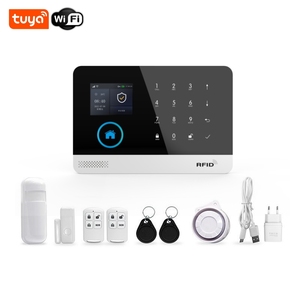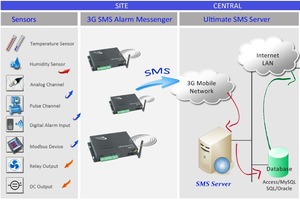
All categories
Featured selections
Trade Assurance
Buyer Central
Help Center
Get the app
Become a supplier

(16452 products available)





















































SCADA GSM alarm systems come in different varieties that fit different business needs and structures.
Hybrid SCADA GSM Alarm System
This kind of system uses both old and new methods to gather data. It keeps the strength of traditional systems while adding the reach of GSM networks. Users can access the SCADA data through various channels, including direct lines and GSM. This choice is useful when changes in technology are gradual rather than immediate.
Real-time SCADA GSM Alarm System
This system sends out alarms and messages as events happen. It uses GSM technology to keep all users updated with real-time data and alerts. This ability to share data immediately helps prevent problems and ensures that big sites are checked on at all times. It's crucial in businesses where even small delays in getting information can be costly.
Distributed SCADA GSM Alarm System
This system spreads its data-gathering points across various locations. Each part collects its own data and sends it back through GSM networks. This design makes the system more reliable. If one part fails, the rest can still work. It's a good fit for big companies with many sites, as it keeps operations steady and easy to manage even when things change.
Event-driven SCADA GSM Alarm System
This kind of system focuses on changes or events rather than steady data collection. It triggers alarms and notifications only when specific situations occur. This helps to cut down on unnecessary alerts and focuses attention only on important changes. In settings where constant data flow can be overwhelming, this selective approach is very helpful.
Most manufacturing companies utilize SCADA GSM alarm systems in their processes. Those alarm systems help monitor machines, detect issues, and send alerts through GSM during emergencies. This allows teams to work faster and fix problems quickly, leading to more efficient production.
Oil and gas firms often operate in locations that are far away from other towns. They rely on SCADA GSM alarm systems to monitor pipelines and ensure safety. The alarms help detect leaks, pressure changes, or any other issues. Workers can then respond quickly, helping to prevent accidents and minimize damage.
Energy companies use SCADA GSM alarm systems to keep track of power plants, grids, and renewable energy sources. These systems help monitor the performance of equipment and send alerts if something goes wrong. This allows maintenance teams to fix issues before they disrupt power supply to homes and businesses.
Water treatment facilities monitor levels and quality using SCADA GSM systems. These alarms ensure that the water is safe to drink and that the treatment process runs smoothly. Any changes in water conditions prompt immediate reaction to maintain public health.
Transportation businesses depend on SCADA GSM alarm systems to supervise trains, subways, and other transit systems. The networks can detect problems on trains or tracks and send alerts. This helps keep commuters safe and ensures public transport systems work well.
Communication providers use these systems to monitor their network infrastructure. SCADA GSM alarm systems help detect issues with towers or other equipment. Fast alerts mean technicians can fix problems promptly, leading to better service reliability.
In construction, big sites run complex operations. SCADA GSM alarm systems monitor tools, power supplies, and safety conditions. Construction managers receive real-time alerts, helping them to manage different aspects of their many, often simultaneous projects safely and efficiently.
Automated systems control production, transport, and mixing in the chemicals and pharmaceuticals sectors. SCADA GSM alarm systems help detect any variance in these tightly controlled processes, ensuring product safety and quality.
SCADA systems are deployed for real-time monitoring and controlling systems in metalworks and mineral extraction. GSM alarms notify personnel of abnormal working conditions, enhancing safety.
The SCADA GSM Alarm system is a technological blend that efficiently combines two critical components: SCADA (Supervisory Control and Data Acquisition) and GSM (Global System for Mobile Communication).
SCADA systems are primarily used to monitor and control industrial processes over large areas. They are widely deployed in sectors like water treatment, oil and gas, power generation, and manufacturing, where processes are distributed over vast geographic regions. SCADA systems collect data from sensors and equipment, allowing operators to visualize and control operations from a centralized location.
On the other hand, GSM is a mobile communication system that provides a reliable means of short-message telecommunication, particularly useful for sending alerts and alarms in real time. GSM networks offer extensive coverage, ensuring that messages can be sent even from remote locations.
Integrating these two technologies has led to the development of SCADA GSM alarm systems that leverage the strengths of both to provide real-time monitoring and alerting capabilities. Here's how they work:
Data Acquisition: The SCADA component of the system is responsible for data acquisition. It collects information from various sensors and devices deployed in the monitored environment. These sensors measure critical parameters such as temperature, pressure, fluid levels, and equipment status. The data is then relayed to a central control unit where it is processed and stored.
Data Processing and Visualization: The processed data is sent to a graphical user interface (HMI) where operators can visualize the system's status through real-time dashboards, charts, and other informational displays. This visualization helps operators quickly assess the health of the systems they manage and identify anomalies.
Threshold Setting: Users typically define acceptable operational thresholds for each monitored parameter. These thresholds are crucial for the next step, as the system will trigger an alert when exceeded.
Alert Generation: When any of these monitored parameters surpasses the predefined thresholds, the SCADA system generates an alarm. This alert indicates an anomaly or potential problem, such as equipment failure, safety issues, or environmental hazards.
Real-time Notification: This alarm is where GSM comes into play. The alert is immediately sent via SMS (Short Message Service) to designated personnel's mobile devices. GSM networks ensure that this message can be received in real time, even in remote areas where the infrastructure might be lacking.
Response and Action: Upon receiving the SMS alert, personnel can promptly respond to the issue. The real-time notification allows for faster intervention, potentially minimizing downtime and preventing more serious incidents.
Real-time Monitoring
SCADA GSM alarm systems provide immediate feedback on critical parameters. They allow operators to watch things like temperatures and pressures in places like factories or power plants from far away. This constant checking helps users spot and fix problems before they become big ones, which is essential for keeping operations running smoothly.
Automatic Alerts
When something goes wrong, like equipment breaking down or conditions changing too much, the system sends out alerts. These messages go straight to people's phones or computers. This keeps teams informed, even if they aren't near a control room. Getting these alerts fast helps users act quickly and reduce risks or downtime.
Scalability
These systems can grow as needs change. If a new site opens or more sensors are needed, the system can easily adjust. It stays effective no matter how big or complex things get. This flexibility is vital for users who want to expand operations without overhauling their entire monitoring setup.
Remote Access
With mobile networks, users can check data and alarms from anywhere, even outside work. This access means quick responses are possible even when far from the site. It enables faster decision-making, which is essential in industries where conditions can change rapidly.
Data History and Analysis
The system keeps a record of all the data it gathers. This data is helpful for figuring out what has happened over time and spotting trends. By analyzing historical information, users can make choices that improve efficiency and stop problems from happening again. This feature supports long-term planning and maintenance strategies in industries with complex operations.
Following are some crucial factors to consider when choosing SCADA GSM alarm systems for different clients:
Industry-Specific Requirements
When choosing an SCADA GSM alarm system, the client’s industry use should come first. Oil and gas companies will need different systems from water treatment plants. To work well, the system must handle tasks unique to that space, like monitoring settings for pressure and flow. Any system designed for a specific client’s business will meet their needs better than a one-size-fits-all solution.
System Scalability
Clients may need to expand their systems later on. The SCADA alarms picked now must grow smoothly with any increase in operational demands or additional sites. Scalability lets businesses grow safely without overhauling their entire monitoring setup.
Reliability and Uptime
Critical places can never afford a failure in the alarm systems. Select systems with strong track records and capable backup features to ensure operating day and night with few to no interruptions. Trustworthy suppliers can hold proven systems that stand up to the test in industries where constant performance is crucial.
Ease of Use
Complex systems are challenging for staff to master. Choose SCADA alarms with simple interfaces for settings and monitoring. Make tasks faster for users. Intuitive designs mean even new operators can get things done easily, allowing prompt responses to any event.
Integration Capability
Clients likely use other tools. Pick systems that integrate easily with existing software, sensors, and communication technologies. Seamless data and alert sharing across platforms makes for more effective monitoring and quick action when issues arise.
A: SCADA stands for Supervisory Control and Data Acquisition. It's a method used to keep an eye on and run systems from far away. GSM is short for Global System for Mobile Communications. It helps send messages through mobile networks. Together, they form a strong alarm system for industries.
A: When something changes too much or breaks, the system sees this and sends an alert. It uses SMS technology to send the alert through mobile networks. This happens even if the people in charge aren't near a computer; they'll get the alert on their phones wherever they are.
A: Yes, they protect against things like hackers or network problems. The designers add features that keep everything secure and working well. Regular checking and updating also help keep the system protected over time. Steps like secure logins, encrypted messages, and using private networks safeguard the system from being accessed or disrupted wrongly.
A: Yes, it saves the information. This allows later checking of data to find trends or issues that happened before. With this past data, the managers can spot patterns and make changes to prevent problems in the future. The ability to collect and analyze historical data improves decision-making and operational efficiency in the long run.